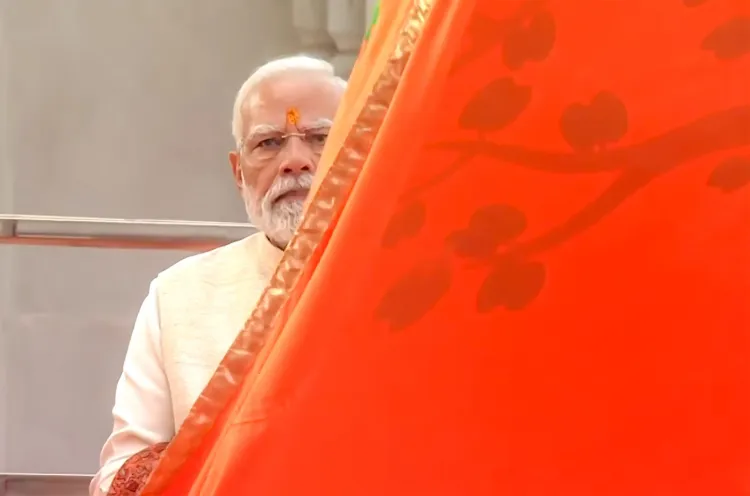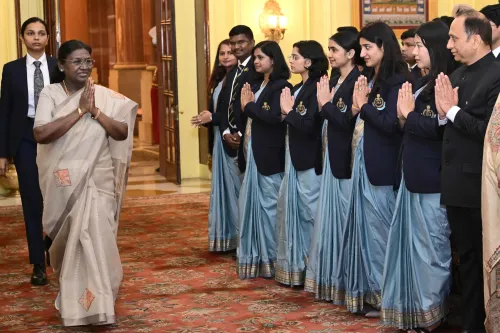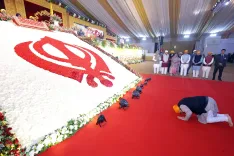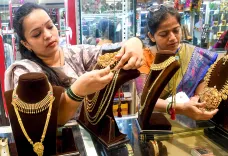Is It India’s New Chapter of Glory?

Synopsis
Key Takeaways
- Prime Minister Modi hoisted a sacred saffron flag at the Ram Janmabhoomi Temple.
- This event is celebrated as India's saga of glory by BJP leaders.
- The flag symbolizes the enduring spirit of Sanatan Dharma.
- The ceremony marks the completion of the temple's construction.
- Sapt Mandir honors key figures in Lord Ram's life.
New Delhi, Nov 25 (NationPress) In a remarkable display of faith and tradition, Prime Minister Narendra Modi presided over the ‘Dhwajarohan Utsav’ at the Ram Janmabhoomi Temple, where he raised a specially crafted sacred saffron flag above the shrine. Numerous BJP leaders celebrated this monumental event, referring to it as India’s “saga of glory.”
BJP National Spokesperson Shahnawaz Hussain expressed to IANS, “Today, PM Modi hoisted the ‘Dharam Dhwaj.’ This signifies to the nation that the symbols of Sanatan Dharma will never again be undermined by invaders. I extend my congratulations to the entire nation for this momentous occasion.” He noted the public's overwhelming happiness regarding the event.
Echoing similar thoughts, BJP National General Secretary Tarun Chugh stated, “Under PM Modi's guidance, the flag has been hoisted at the Ayodhya Ram Temple. This marks India’s ‘saga of glory’ and is a moment of pride for all Hindus and devotees of Sanatan Dharma. While some parties opposed the Ram Temple's construction, PM Modi has made this long-held dream a reality.”
BJP Rajya Sabha MP Dinesh Sharma remarked, “Ram Lalla is now enshrined in Ayodhya, and the temple's construction is complete. This event signifies the end of a long struggle. Raising the flag symbolizes the successful culmination of this endeavor, dedicated to the welfare of all.”
At approximately 12 noon, Prime Minister Modi and RSS chief Mohan Bhagwat led the 'Dhwajarohan Utsav' by hoisting the specially-designed sacred saffron flag at the temple.
This 22-foot-long and 11-foot-wide flag, crafted by a parachute specialist from Ahmedabad, Gujarat, weighs between 2 to 3 kilograms and is engineered to endure high altitudes and winds. It features the Sun symbol, indicative of Lord Rama's Suryavanshi lineage and celestial brilliance, along with images of the Kovidara tree, the Sun, and Om. The saffron hue represents fire, dawn, sacrifice, and commitment.
The ceremony signifies another milestone in the ongoing cultural renaissance associated with Ayodhya, with leaders highlighting that the flag represents not just religious devotion but also India’s lasting civilizational spirit. This event also marks the completion of the temple's construction.
Earlier, PM Modi offered prayers at the Sapt Mandir within the expansive Ram Temple complex, which honors revered figures such as Maharishi Vashistha, Maharishi Vishwamitra, Maharishi Agastya, Maharishi Valmiki, Goddess Ahalya, Nishadraj Guha, and Mata Shabari.
The Sapt Mandirs symbolize the esteemed gurus, devotees, and companions who significantly influenced Lord Ram's journey, underscoring their lasting importance.









